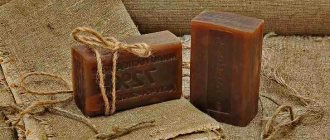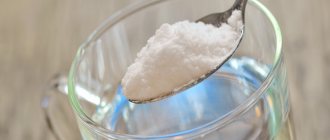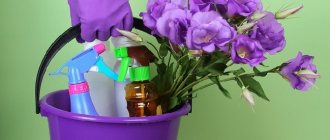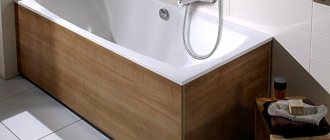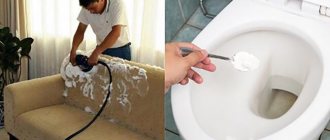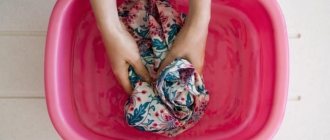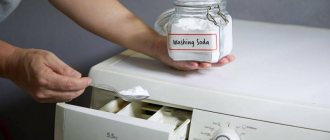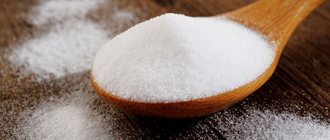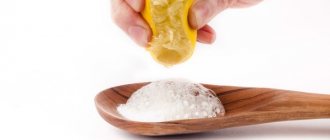What kind of substance is soda ash?
The substance is actively used at home and is available in the form of crystalline powder or granules. Soda ash is extracted from minerals, as well as through special reactions. You may come across several names for this powder: sodium carbonate, technical soda, sodium carbonate or sodium carbonate. They are all the same substance - soda ash.
Properties of soda ash
The formula of the substance is a close bond of 2 sodium molecules, 1 carbon and 3 oxygen. The sodium salt of carbonic acid actively enters into chemical reactions with various substances, which is why it is widely used in production and at home.
Sodium salt is highly soluble in water and interacts with moisture, so keeping it in an open container in highly humid places is not recommended.
In the industrial sphere, the substance is used in soap making, as components of household chemicals and some enamels, and in glass production.
Is soda ash an alkali or an acid?
If you look at the formula of the substance, you will notice that soda ash is a salt that, when interacting with water, forms an alkaline environment. Sodium salt has a fairly high pH of 11, so in most cases it can be used instead of alkali. The substance is not an acid.
How to use soda ash in the kitchen
Soda ash can replace a number of household chemicals. The substance is useful for cleaning the kitchen and washing dishes.
Dishwashing liquid
You can make a natural dishwashing detergent from sodium salt. To do this, prepare a solution of 0.5 liters of water and 1.5 tbsp. spoons of the substance. As with regular dishwashing detergent, apply the liquid to a sponge and scrub plates, cups and cutlery. After washing, be sure to rinse the dishes with clean water.
You can also use technical soda to wash dishes in the dishwasher. To do this, when fully loaded, add 2 teaspoons of sodium salt and the same amount of borax to the tank, and turn on the washing function. After completing the procedure, the plates will not only be clean, but also disinfected.
Cleaning difficult stains
If, over time, the cutlery has turned yellow, and a slight soot or scale has appeared on the dishes, try preparing a washing solution based on sodium salt with the addition of liquid and laundry soap.
Prepare a large saucepan and fill it halfway with water. Add here 100 g of sodium carbonate powder, the same amount of laundry soap shavings and 100 ml of liquid soap. Place dirty dishes in a container and boil for 20 minutes. Rub the softened dirt with a sponge, then rinse the containers and utensils to be cleaned with clean water.
Carbon remover
Using soda ash, you can remove stubborn carbon deposits on pans and pots.
Please note that it is strictly not recommended to process containers made of aluminum, cast iron or copper.
This method of removing carbon deposits is more suitable for enamel and ceramic containers. For the procedure you will need:
- 1 package of soda ash;
- a bar of laundry soap;
- 2–3 bottles of silicate glue;
- large capacity for boiling.
Procedure:
- Place the container to be cleaned in a large saucepan.
- Fill with water.
- Add a packet of sodium carbonate to the liquid.
- Pour silicate glue into this and add a pod of laundry soap.
- Place the container on the stove and turn on the heat.
- Boil the mixture. Adjust the boiling time yourself depending on the degree of contamination. Typically cleaning takes from 20 minutes to 2 hours.
- Turn off the heat and cool the container being processed.
- At the last stage, rinse all the pots under running water.
Treatment with sodium salt will help get rid of not only carbon deposits, but also other contaminants and deposits.
How to clean tiles
You can use a cleaning composition made from soda ash to wash tiles in any room. To prepare it, add 60 g of the substance to 1 liter of water and mix thoroughly. Apply the product to the tiles and scrub with a metal sponge. After treatment, wash the surfaces with a damp cloth.
Stove cleaning paste
To remove stubborn greasy stains on grates and stovetop or oven surfaces, you can prepare a solution of sodium salt.
Step by step steps:
- Mix 6 tbsp in 2 liters of water. spoons of technical soda, 2 tbsp. spoons of regular washing powder and the same amount of silicate glue.
- Mix the ingredients thoroughly.
- Treat all contaminated surfaces with the mixture.
- Leave the solution to act for 10-12 minutes.
- Remove softened dirt with a damp sponge.
Repeat the procedure if necessary. The finished solution can be stored, but only in tightly closed containers.
Cleaning the kettle from scale
Technical soda does an excellent job of removing scale from inside teapots. To treat the inner surface of a classic or electric kettle, you can prepare 2 solutions using different methods.
Method 1:
- Fill the kettle with water to the maximum level.
- Add powder to the water at the rate of 1 teaspoon of powder per 1 liter of water.
- Boil water in a kettle for 5 minutes.
- Drain off any remaining sediment.
- At the last stage, boil clean water in a kettle.
Method 2:
- Apply a small amount of sodium carbonate to a damp sponge.
- Scrub the interior surfaces thoroughly with the sponge.
- Pour clean water into the kettle and boil.
- Drain the water and rinse the container thoroughly.
Using similar methods, you can process not only teapots, but also any other utensils.
Make it at home
If you urgently need soda ash, you can make it yourself. To do this, you need to degrease the baking sheet by washing it with dishwashing detergent. Wipe well, pour baking soda up to half the sheet. Place in an oven preheated to 230°C and bake for an hour, stirring occasionally. Then cool.
Calcined salt is very hygroscopic, so it must be stored in a tightly closed container.
Soda ash for cleaning plumbing fixtures
Sodium salt-based cleaners do an excellent job of removing limescale and stains on plumbing fixtures. To treat a toilet, sink or bathtub, you can use several options for a solution of the substance.
Soda-soap mixture
To prepare, you will need 100 g of technical soda and the same amount of laundry soap shavings. Mix the soap and powder thoroughly. Add a little water to the mixture until you get a thick paste. For aroma, you can add a few drops of aromatic oil to the mixture.
Apply the resulting mixture to the plumbing fixtures and leave to act. After 60 minutes, remove the cleaning mixture with a cloth and rinse the surface.
Treatment with vinegar and soda ash
Plumbing treatment is carried out in 2 stages. Initially, treat the bathtub, sink or toilet with table vinegar. After this, sprinkle the surface with soda ash powder. Wait 15 minutes, then scrub the stains with a sponge and rinse the surface with water.
How to clean an old bathtub with a mixture of two types of soda
For such processing you will need not only soda ash, but also baking soda. In addition, prepare some water, vinegar and bleach for the procedure.
Procedure:
- Mix 2 types of soda in equal proportions and dilute a little with water to a paste.
- Apply the substance to the surface of the bathroom.
- Leave to act for 10–15 minutes.
- Meanwhile, combine equal amounts of vinegar and bleach.
- Apply the chlorine-acetic mixture to the surface.
- Leave to act for 30 minutes.
- Rinse off any remaining detergent with clean water.
In a similar way, you can clean not only the bathtub, but also other plumbing fixtures: the toilet or sink.
How to clear clogged pipes
Soda ash solution helps clear blockages in pipes. The substance perfectly corrodes food debris, greasy and old plaque. You can prepare the product in two ways.
Method No. 1 with boiling water
To clean, you will need 125–150 g of the substance and 1 liter of boiling water. Pour baking soda into the drain hole and pour boiling water over it. Wait for 30 minutes and then flush the drain with plenty of water.
Method number 2 with vinegar
For the second cleaning option, in addition to soda ash, you will need 150 ml of vinegar and the same amount of bleach. Pour sodium salt into the drain, then add vinegar and bleach. Close the hole with a stopper and leave for 30 minutes. After this, pour 3 liters of boiling water into the drain. Be careful, chlorine vapors are very dangerous, so cover your mouth with a bandage and open all windows in the room. At the end of the procedure, rinse the drain with running water.
History of discovery
Humanity became acquainted with laundry soda a long time ago - 2,000 BC. The ancient Egyptians extracted it from lake waters. Soda was used to melt glass and replaced a detergent.
The word “soda” comes from the phrase “solyanka”. This term denoted a plant that ancient people burned to obtain ash. Then it was heated to high temperatures, i.e. calcified. The substance obtained as a result of such actions was soda ash. Soda was mined in this way until the beginning of the 19th century.
The idea of producing laundry soda artificially belongs to the French pharmacist N. Leblanc. He proposed to extract this substance by calcining a mixture of sodium sulfate, coal and crushed chalk. From this composition, sodium carbonate was leached with water, then the solution was evaporated, and pure soda ash was isolated. The released calcium sulfate was considered a production waste.
Subsequently, new methods for extracting laundry soda were developed, which produced much less waste.
In nature, large quantities of sodium carbonate are found in the form of underground ground brines, as well as brine in salt lakes.
Large deposits of this compound are located in Canada, the USA, Mexico, Kenya, and South Africa. There are soda lakes in Western Siberia and Transbaikalia.
Methods for using soda ash to wash clothes
One of the main properties of the substance is the purification of natural materials from contaminants. You can use soda ash for soaking, boiling, hand washing or automatic washing. Please note that only natural materials made from cotton and linen can be treated with a solution of technical soda.
Soak
The soaking procedure is more suitable for white materials, since colored items may lose color saturation.
Rules for soaking products in a sodium carbonate solution:
- Dissolve 75 g of powder in 5 liters of water.
- Place the product in a container with the solution and leave overnight.
- If there are persistent stains on your clothes, wash the stains with laundry soap before the procedure.
- After treatment, wash your clothes as usual.
To soak colored items, so as not to spoil the color fastness, prepare a less saturated solution by dissolving 1.5 tbsp in 5 liters of water. spoons of powder. Processing instructions remain unchanged.
Handwash
You can use soda ash both instead of washing powder and to soften water and strengthen detergent.
Before the procedure, be sure to wear gloves on your hands to prevent skin burns. If the solution gets on your hands, rinse the skin with plenty of water, dry it and lubricate it with a rich cream.
Machine washable
When used in automatic washing, soda ash will not only improve the quality of the powder, but will also remove scale and limescale deposits in the washing machine.
Add 75 g of soda to the washing machine compartment along with the powder and run a standard wash.
Fight stubborn stains
If you have stubborn grease or gasoline stains on your clothes, use a little more soda ash powder than you would with normal washing. For example, to wash heavily soiled items in automatic washing, add 5 tbsp to regular powder. spoons of sodium carbonate.
Boiling laundry
Boiling with technical soda will help improve the bleaching effect. The procedure will not only remove contamination, but also disinfect the material.
Mode of application:
- For boiling, choose a container made of metals that do not react with the substance. It is strictly not recommended to use aluminum and copper pans.
- Before the procedure, provide access to fresh air in the room, and during the procedure, try not to inhale fumes.
- Dissolve 500 g of soda ash powder and 500 ml of white in 10 liters of water.
- Place the laundry in a pan and boil for 40–60 minutes.
After the procedure, wash your items as usual.
Washing gel
You can make an effective hand washing gel from soda ash. In addition to sodium carbonate, you will need:
- 2 tbsp. spoons of glycerin;
- 100 g laundry soap;
- a few drops of essential oil.
Cooking method:
- Boil 2 liters of water.
- Add laundry soap to the liquid.
- Boil the mixture until the soap is completely dissolved.
- Add 150 g of sodium salt.
- Boil the solution for 3 minutes.
- Remove the container from the heat and add glycerin.
- At the last stage, pour essential oil into the mixture and mix thoroughly.
When the mixture has cooled completely, pour it into a beautiful bottle and use it instead of hand wash gel.
Soda ash for washing baby clothes
You can also use a gel made from soda ash to wash children's clothes. The main condition is that the product is made of cotton or linen. You can also soak baby clothes in a solution and sodium salt by dissolving 50–75 g of powder in 5 liters of water.
Precautionary measures
Soda ash is not nearly as safe as baking soda. Therefore, always work with gloves, and after each procedure, do not forget to thoroughly rinse off any remaining product with water. Also follow the following three rules.
- Further from products. Do not store laundry soda with food, and keep it away from children and four-legged pets.
- Eyes and skin. If lye splashes into your eye or gets on your skin, rinse the area with plenty of clean water.
- Use a respirator. Too much sodium carbonate can cause respiratory irritation. If there is no protective mask, perform all manipulations with an outstretched arm.
Now you know what soda ash is needed for. However, the scope of its application is very wide and is not limited to everyday life. Its properties are used in livestock farming and industrial production. Judging by the reviews, robes and overalls washed with sodium carbonate look like new.
Removing scale and limescale
If scale and limescale have appeared on pots or other containers, a product based on sodium salt will help. You can clean the container in two ways
Method No. 1
Fill the container 2/3 full with water. Add 75 g of soda to the liquid. Place on fire and boil for 20 minutes. After this, turn off the heat and leave the solution to act. After an hour, scrub the inner surfaces with a metal sponge and rinse the container thoroughly.
Method No. 2
For the procedure you will need soda ash and citric acid.
Procedure:
- Fill the container with water.
- Add the required equal amount of sodium salt and citric acid at the rate of 1 teaspoon per 0.5 liter of water.
- Place the pan on the fire and boil the water.
- Let the solution boil for 15 minutes.
- Turn off the heat and leave the container with the cleaning mixture for 1 hour.
- Turn on the stove again and repeat the procedure.
- Cool the container again and drain the liquid.
- If necessary, scrub heavily soiled areas with a metal sponge.
- Fill the container with clean water and boil a little again.
- At the last stage, drain the water and rinse the container under the tap.
Mopping floors
You can use soda ash to clean floors. Pre-prepare a sodium carbonate-based product and then add a small amount to the water for treating floors.
To prepare the product you will need 25–50 g of soda ash and the same amount of liquid soap. Dilute the ingredients in 3 liters of water and pour into a beautiful container. Add the substance to the water when treating floors. For severe stains, apply detergent directly to the stains, leave for 10-15 minutes and wipe with a cloth. After treating with sodium carbonate, be sure to wipe the surfaces with a clean, damp cloth.
Please note that if the floors are made of wood, parquet or laminate, the use of soda ash is not recommended. The same applies to coatings painted with enamel or varnish.
Disinfection
Soda ash not only helps with cleaning, but can also disinfect surfaces. To prepare a disinfectant composition, you will need a bucket of water, 200 g of sodium salt and the same amount of laundry soap. Dissolve the substances in water and thoroughly treat all surfaces. Use the soap solution daily immediately after preparation. To wash tiles, replace laundry soap with 50 g of washing powder.
Cleaning household appliances
With the help of technical soda, you can easily clean household appliances in the kitchen. The solution of the substance does a good job of cleaning the refrigerator, microwave oven, hood and other work surfaces.
To prepare the cleaning solution you will need 6 tbsp. spoons of sodium carbonate and 2 liters of water. Thoroughly dilute the powder in liquid and pour into a container with a spray bottle.
Mode of application:
- Spray the solution onto the surface to be cleaned.
- Leave the product to act for 5-7 minutes.
- Rinse off any remaining substance with clean water.
- Wipe the surface dry.
To clean the microwave oven from grease and dirt, place a container with the solution inside the oven and turn on the heat for 5 minutes. The fatty deposits will soften and you can easily wipe them off with a napkin.
How to remove old paint using soda ash?
Soda ash actively interacts with paint molecules, corroding their structure. This property allows the substance to be used as a paint solvent.
Before you start the procedure, be sure to take safety precautions. When heated, the lime used for the recipe releases chlorine-containing vapors that are dangerous to humans. Put a respirator and safety glasses on your face, and put rubber gloves on your hands.
Procedure:
- Pour 5 liters of water into a large container prepared in advance so that it does not occupy more than 1/3 of the volume.
- Add 1 kg of soda ash to the liquid.
- Heat the mixture to 60 degrees.
- Mix lime with water and add little by little to the solution.
- Apply the finished mixture to the surface to be cleaned with a brush.
- When the paint has softened a little, scrape it off with a spatula.
After treatment, wash off any remaining paint with solvent or water.
Can I wash with this product?
The product perfectly deodorizes, disinfects and cleanses . This allows it to be used as a detergent.
Washing with soda is safe for health, does not harm the washing machine and improves the final result of the procedure.
The product can be used both in pure concentration and as part of a mixture. Many housewives simply add baking soda to washing powder. At the same time, things become softer, the colors of the fabrics become richer.
What materials cannot withstand the effects of soda ash?
Despite the widespread use of soda ash in everyday life, it is still not recommended for cleaning certain materials. These include:
- aluminum;
- cast iron;
- copper;
- tree;
- fiberglass;
- brick;
- laminate and parquet;
- paints;
- enamels;
- varnishes;
- wool;
- click;
- suede leather;
- leather.
The sodium salt actively interacts with these materials, corroding their molecules. If you apply even a small amount of the substance to such a surface, you risk damaging the product.
In addition, the use of the substance on synthetic and plastic surfaces, as well as suspended ceilings, is extremely dangerous, since it is unknown what exactly is included in the synthetic material and how its components will react to the effects of sodium salt.
Briefly about the main thing
- Soda ash is a universal and inexpensive cleaning product that has a cleaning effect.
- The effect of soda can be enhanced by other means: citric acid, vinegar, hydrogen peroxide.
- The product must be used with caution: baking soda is a strong alkali, which is not suitable for washing finicky fabrics or cleaning wooden and plastic surfaces.
- When working, take precautions and use skin and mucous protection products.
- Sometimes it's better not to experiment. Order maintenance cleaning: cleaners will carefully deal with complex stains and restore the appearance of any, even the most capricious coatings and materials.
Storing soda ash
Soda ash tends to absorb moisture and carbon dioxide from the air, as a result of which it loses its characteristics. To prevent this when storing the powder, adhere to the following recommendations:
- Do not keep sodium carbonate in an open cardboard container, otherwise it will lose its properties in just 25 days.
- For storage, choose a glass container with a tight lid, then the powder will last as long as possible - for 5 years.
- Do not allow air to enter the substance, make sure that the jar is always closed.
- Make sure that containers with sodium salt are kept away from food products, since the substance can cause burns to the gastrointestinal tract if it enters the body.
To store sodium salt and products based on it, choose places inaccessible to children.
How is it different from food
What is the difference between soda ash and baking soda? At least because food grade can be used in cooking, but sodium carbonate cannot. There are four more differences.
- Alkaline reaction. In sodium carbonate it is more powerful - ph11, in baking soda - ph8.
- View. Sodium carbonate has a different composition and a looser structure.
- Power of influence. The non-food compound is usually used to clean areas that are too dirty and that regular baking soda can't handle.
- Safety. Although soda ash is not as dangerous as caustic soda, you still need to take precautions when interacting to protect your skin, nose, mouth and eyes.
Don’t even think about tasting laundry soda, much less adding it to food and placing it on the same shelf as food products.
Where to buy soda ash
You can purchase a package of soda ash in any supermarket in the household chemicals department or in a hardware store.
Usually the powder is packaged in packages of 600 g, less often 800 g. In the gardening department you can also buy the substance in 25 kg bags. The cost of one six-hundred-gram pack varies between 40–60 rubles, and a large 25 kg bag varies between 1200–1300 rubles.
Soda ash can safely be called a universal substance for household use. With the help of sodium carbonate, you can clean the entire apartment, wash and disinfect dishes, and wash heavily soiled clothes. Using sodium salt as an analogue of popular household chemicals, you will significantly save time and money.



